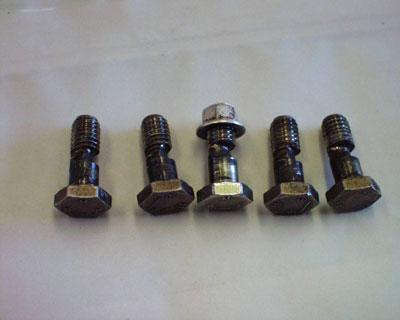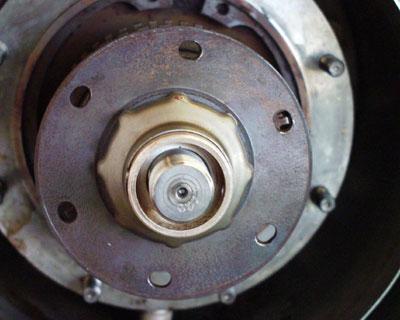An abnormal noise coming from the left engine of an Aerospatiale AS.332L Super Puma helicopter, registered VH-BHY, was reported by several operating crews over the course of successive charter flights. The noise and vibration was evident at approximately 26,000 rpm during acceleration and deceleration phases, and could be induced by rapid movement of the speed select lever.
Although the engine was operating within the manufacturer's vibration limit, maintenance personnel continued to investigate the cause of the vibration. It was discovered that the six attachment bolts at the engine end of the Bendix driveshaft had worn through approximately 50 percent of their thickness. There was evidence of fretting of the mating surfaces of the Bendix and engine coupling plates. The engine attachment plate for the Bendix also incurred severe elongation of the bolt holes. This condition, if left undetected, would have resulted in the loss of drive from the left engine to the main gearbox. Maintenance personnel could draw no conclusion as to how this damage had occurred. The operator had not seen this type of wear before on other Super Pumas either in Australia, or with its North Sea operation. The Bendix shaft had completed approximately 380 hours in service since installation.
Figure 1: Bolt wear through 50% thickness.
Figure 2: Engine drive adaptor elongated bolt holes
New Bendix attachment bolts, along with several of the damaged bolts were forwarded to the Australian Transport Safety Bureau (ATSB) for laboratory analysis. The examination found no evidence of material deficiencies or other anomalous features of the bolt construction that would have rendered the items susceptible to the type of damage observed. The ATSB concluded that the damage sustained by the Bendix attachment bolts supplied was consistent with the effects of inadequate bolt tightness. Breakaway torque tests conducted at the operator's facilities under ATSB supervision confirmed that the locking nuts had appropriate locking capability to retain torque applied to them.
The engine was shipped to the manufacturer in France for further testing. The tests were conducted under the supervision of the Bureau Enqutes Accidents (BEA) on behalf of the ATSB. The engine was instrumented and run in a test cell, which confirmed the vibration levels reported by the operator. The levels observed were close to the maximum values permitted for this engine type. A disassembly inspection revealed rub damage to the abradable seal of the free turbine front and rear labyrinths consistent with unusual movement of the free turbine bearing. The movement was probably induced by radial loads as a consequence of the lack of torque on the Bendix attachment bolts and nuts. The phonic wheel also exhibited rubbing damage to the circumferential teeth. The damage to the engine, observed by the manufacturer and the BEA, in their opinion was consistent with inadequate torque of the bolts and nuts which secured the Bendix coupling to the engine drive flange connection.
Interviews with the operator's engineering staff established that an oil seal was changed in the vicinity of the shaft attachment bolts approximately 46 flying hours prior to discovery of the bolt wear. The engineers stated that this maintenance activity did not require that the Bendix attachment bolts be disturbed to accomplish the task. The engineers were those that originally fitted the shaft to the helicopter. When queried about the shaft fitment, they could not recall any external factors that may have caused distraction from the task. The personnel were appropriately licensed and experienced on the helicopter type. The task was not classified as difficult or unusual and had been performed on numerous occasions by this engineering team.
The operator noted that between the time the Bendix shaft was fitted and the discovery of the defect, the aircraft had moved location from Karratha to Darwin and return. The aircraft had accumulated approximately 380 hours since the shaft was installed. Engineers suggested that the forward end of the shaft might have been disturbed for fault tracing of the excessive vibration while in Darwin. No maintenance records were found to indicate that the bolts had been disturbed and the Darwin engineers stated that, to their knowledge, the shaft was not disturbed during the vibration fault finding.
The investigation could not determine the factors relating to the loss of torque of the retention hardware.




